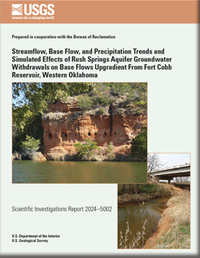Streamflow, Base Flow, and Precipitation Trends and Simulated Effects of Rush Springs Aquifer Groundwater Withdrawals on Base Flows Upgradient From Fort Cobb Reservoir, Western Oklahoma
Links
- Document: Report (6.76 MB pdf) , HTML , XML
- Data Release: USGS Data Release - MODFLOW-NWT model used to evaluate groundwater withdrawal scenarios for the Rush Springs aquifer upgradient from the Fort Cobb Reservoir, western Oklahoma, 1979–2015, including streamflow, base flow, and precipitation statistics
- Download citation as: RIS | Dublin Core
Abstract
To better understand the relation between groundwater use in the Rush Springs aquifer and inflows to the Fort Cobb Reservoir, the U.S. Geological Survey, in cooperation with the Bureau of Reclamation, used a previously published numerical groundwater-flow model and historical streamflow records to evaluate four scenarios to investigate how changing groundwater withdrawals could affect base flows in streams that flow into Fort Cobb Reservoir. These scenarios consisted of observing simulated base-flow response by (1) scaling the 20-year equal-proportionate-share groundwater-withdrawal rate by various percentages over a 50-year period; (2) scaling the historical groundwater-withdrawal rates by various percentages across the entire Rush Springs aquifer; (3) scaling the historical groundwater-withdrawal rates within various subareas (zones) of the Fort Cobb Reservoir surface watershed; and (4) simulating a base-flow-depletion scenario. Cobb, Lake, and Willow Creeks are the major streams upgradient from the Fort Cobb Reservoir (listed from highest to lowest mean annual base flow). The results of scenarios 1 and 2 indicated that Willow Creek is the most susceptible to drying, but Cobb Creek was the most likely to have reduced base flow. Scenarios 3 and 4 indicated that groundwater withdrawals affect Cobb Creek base flows over a broader watershed area compared to Lake and Willow Creeks. In scenario 4, Cobb Creek base-flow depletion was higher across a larger area than Lake Creek and Willow Creek. Groundwater withdrawals in the Cobb Creek watershed tended to affect total inflows into Fort Cobb Reservoir more than other areas in the extent of the Rush Springs aquifer.
Suggested Citation
Trevisan, A.R., Labriola, L.G., and Ellis, J.H., 2024, Streamflow, base flow, and precipitation trends and simulated effects of Rush Springs aquifer groundwater withdrawals on base flows upgradient from Fort Cobb Reservoir, western Oklahoma: U.S. Geological Survey Scientific Investigations Report 2024–5002, 42 p., https://doi.org/10.3133/sir20245002.
ISSN: 2328-0328 (online)
Study Area
Table of Contents
- Acknowledgments
- Abstract
- Introduction
- Streamflow, Base-Flow, and Precipitation Trends and Groundwater Withdrawals
- Simulated Effects of Rush Springs Aquifer Groundwater Withdrawals on Base Flows
- Summary
- References Cited
| Publication type | Report |
|---|---|
| Publication Subtype | USGS Numbered Series |
| Title | Streamflow, base flow, and precipitation trends and simulated effects of Rush Springs aquifer groundwater withdrawals on base flows upgradient from Fort Cobb Reservoir, western Oklahoma |
| Series title | Scientific Investigations Report |
| Series number | 2024-5002 |
| DOI | 10.3133/sir20245002 |
| Publication Date | March 04, 2024 |
| Year Published | 2024 |
| Language | English |
| Publisher | U.S. Geological Survey |
| Publisher location | Reston, VA |
| Contributing office(s) | Oklahoma-Texas Water Science Center |
| Description | Report: x, 42 p.; Data Release |
| Country | United States |
| State | Oklahoma |
| Other Geospatial | Fort Cobb Reservoir |
| Online Only (Y/N) | Y |


